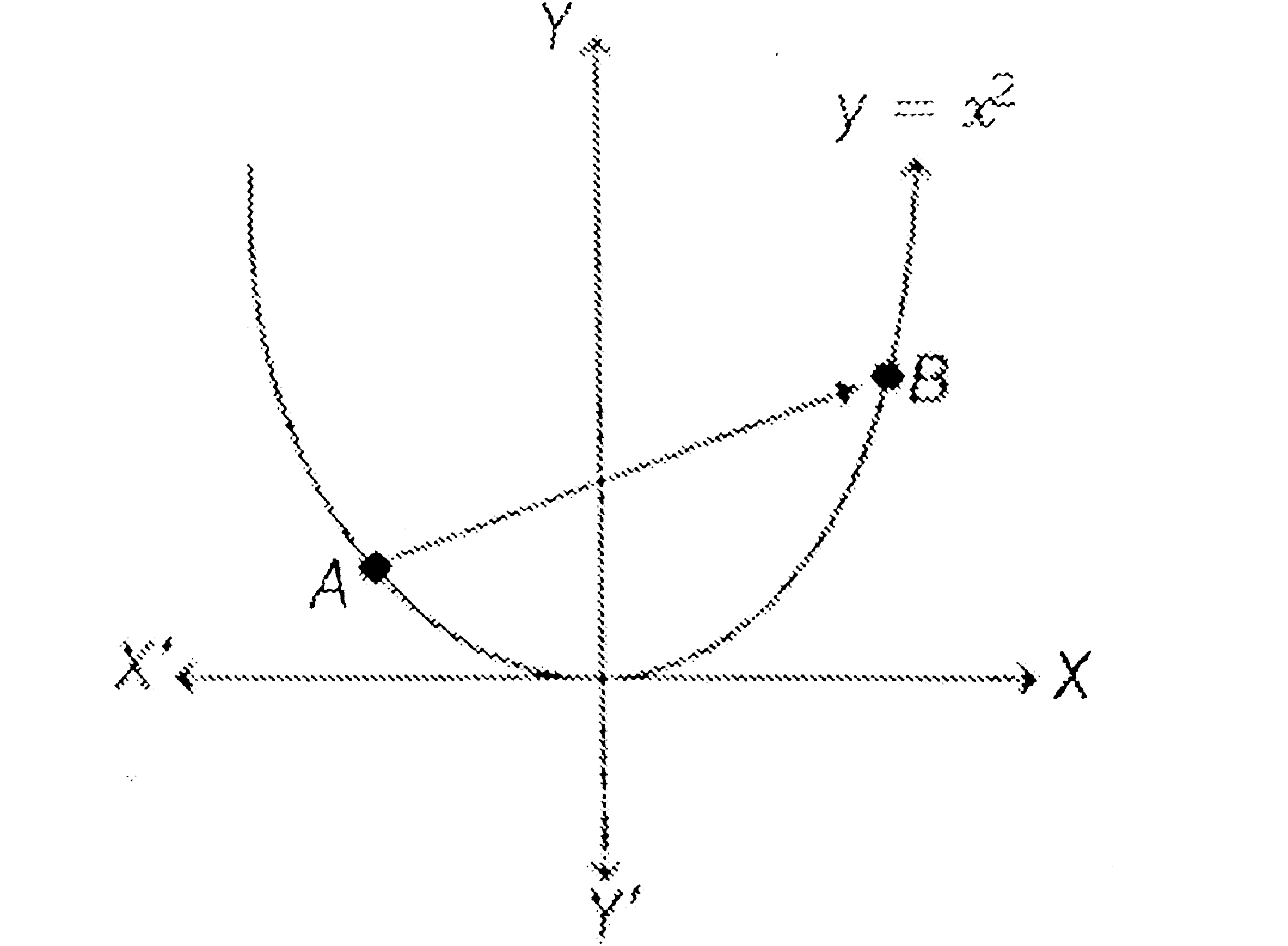What normal to the curve y=x2 forms the shortest chord?
Video Solution
Text Solution
The correct Answer is:√2x−2y+2=0;√2x+2y−2=0

Any point on the parabola y=x2 is of the form (t,t2).
Now, dydx=2x⇒[dydx]x=t=2t
Which is the slope of the tangent. So, the slope of the normal to y=x2 at A(t,t2) is
y−t2=(−12t)(x−t) ... (i)
Suppose Eq. (i) meets the curve again at B(t1,t21).
Then, t21−t2=−12t(t1−t)
⇒(t1−t)(t1+t)=−12t(t1−t)
⇒ (t1+t)=−12t
⇒ t1=−t−12t
Therefore, length of chord,
L=AB2=(t−t1)2+(t2−t21)2
(t−t1)2[1+(t+t1)2]
=(t+t+12t)2[1+(t−t−12t)2]
⇒L=(2t+12t)2(1+14t2)=4t2(1+14t2)3
On differentiating w.r.t. t, we get
dLdt=8t(1+14t2)3+12t2(1+14t2)2(−24t3)
=2(1+14t2)2[4t(1+14t2)−3t]
=2(1+14t2)2(4t−2t)=4(1+14t2)2(2t−1t)
For maxima or minima, we must have dLdt=0
⇒ 2t−1t=0⇒t2=12
⇒ t=±1√2
Now, d2Ldt2=8(1+14t2)(−12t3)(2t−1t)+4(1+14t2)2(2+1t2)
⇒ [d2Ldt2]t=±1/√2=0+4(1+12)2(2+2)>0
Therefore, L is minimum, when t=±1/√2. For t=1/√2, point A is (1/√2,1/2) and point B is (−√2,√2). When t=−1/√2, A is (−1/√2,1/√2), B is (√2,2).
Again, when t=1e/√2, the equation of AB is
y−212−2=x+√21√2+√2
⇒ (y−2){(1√2+√2)}=(x+√2)(12−2)
⇒ −2y+4=√2x+2
⇒ √2x+2y−2=0
and when t=−1/√2 , the equation of AB is
y−212−2=x−√2−(1√2)−√2
⇒(y−2)(−1√2−√2)=(x−√2)(12−2)
⇒ 2y−4=√2(x−√2)
⇒√2x−2y+2=0
|
Updated on:21/07/2023
Topper's Solved these Questions
- BOOK - IIT JEE PREVIOUS YEARCHAPTER - APPLICATION OF DERIVATIVES EXERCISE - MAXIMA AND MINIMA ( INTEGER ANSWER TYPE QUESTIONS)8videos
APPLICATION OF DERIVATIVES
- BOOK - IIT JEE PREVIOUS YEARCHAPTER - APPLICATION OF DERIVATIVES EXERCISE - MAXIMA AND MINIMA (PASSAGE BASED PROBLEMS)3videos
APPLICATION OF DERIVATIVES
- BOOK - IIT JEE PREVIOUS YEARCHAPTER - 3D GeometryEXERCISE - Equation of Plane Objective Question II (Integer Answer Type Question)1videos
3D Geometry
- BOOK - IIT JEE PREVIOUS YEARCHAPTER - AREAEXERCISE - AREA USING INTEGRATION55videos
AREA
Similar Questions
Knowledge Check
- Question 1 - Select One
Slope of normal to the curve y=x2−x and x=2 is
A−13B−17C−19D−111 - Question 2 - Select One
The equation of normal to the curve y=6−x2, where the normal is parallel to the line x−4y+3=0 is
Ax-4y-6=0Bx+4y-6=0Cx-4y+6=0Dx+4y+6=0 - Question 3 - Select One
The equation of the normal to the curve y=e−2|x| at the point where the curve cuts the line x=1/2 is
A2e(ex+2y)=e2−4B2e(ex−2y)=e2−4C2e(ey−2x)=e2−4Dnone of these
The equation of normal to the curve y=x2+2 at point (1,1) is :
View SolutionThe equation of the normal to the curve y=e−2|x| at the point where the curve cuts the line x=−12, is
View SolutionThe equation of the normal to the curve y=x(2−x) at the point (2, 0) is
View SolutionEquation of the normal to the curve y=−√x+2 at the point (1,1)
View SolutionEquation of normal to the curve y = x (2 - x) at the point (2, 0) is
View Solution

